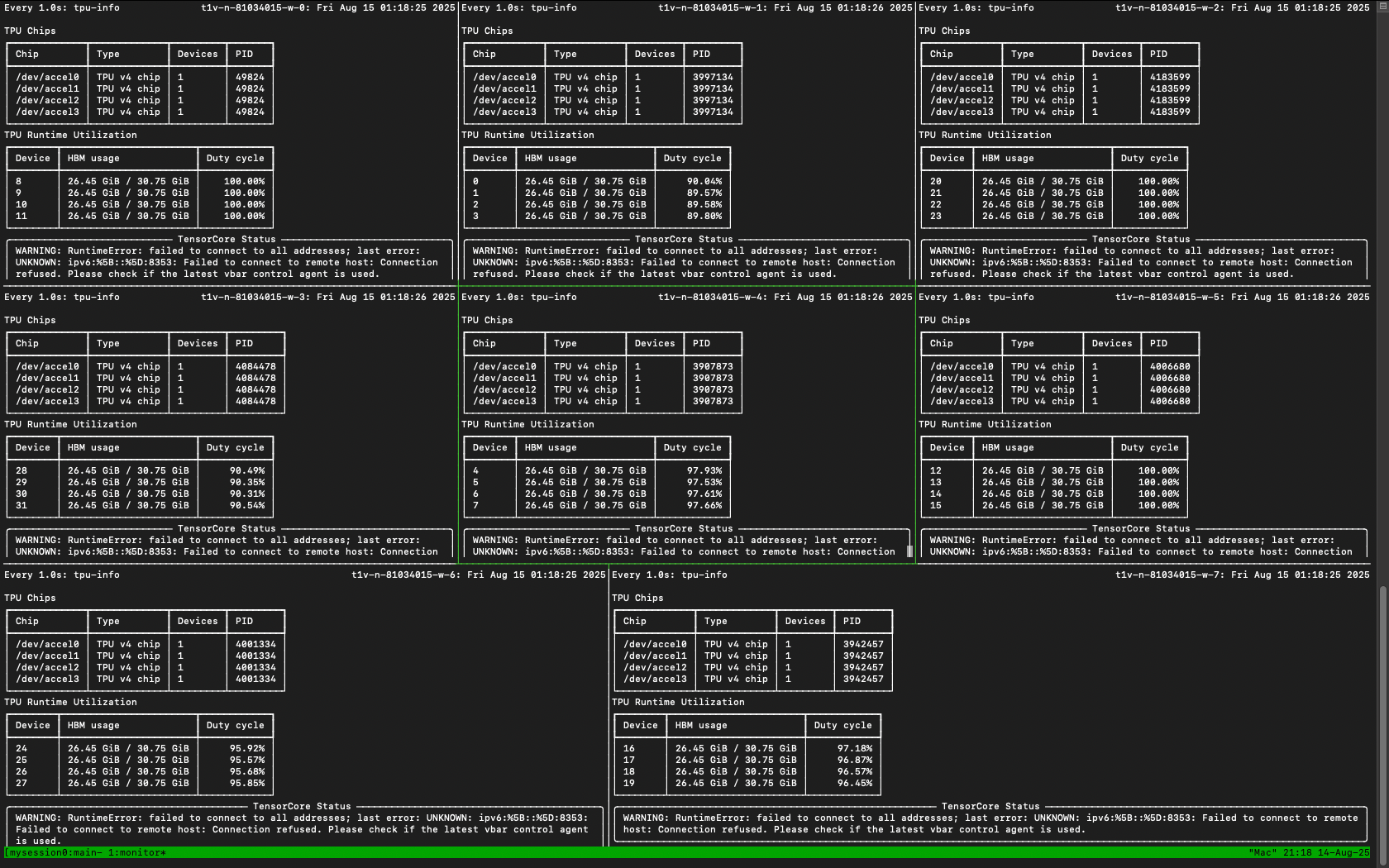Final Run and Training Results
Part 7 of Jaxformer (Part 6: Mixture of Experts | Part 8: Conclusion)
We now write the launch scripts and launch the final run, showcasing how to use multi-controller JAX to conduct large scale, multi-host training runs.
Final Run Scripts
Launcher and Run Scripts
There are two main scripts that are significant for launching a training run. The first is found in the launcher.sh script which contains the IP addresses for all the TPUs as well as a command that launches a training run on each TPU. The command printf "%s\n" "${IPS[@]}" | xargs -n 1 -P 0 -I {} bash run.sh {} does the following:
-
printf "%s\n" "${IPS[@]}"prints each address in the IPS variable on a seperate line -
| xargstakes the argument from the ip and runs the command on all distributed devices at once -
-n 1runs the command once per input item (each IP gets its ownbash run.sh {}call) -
-P 0runs as many process in parallel where each IP will be processed on a distinct device -
-I {}placeholder for the IP argument -
bash run.sh {}calls therun.shscript passing the IP as an argument
#!/bin/bash
source .env
IPS=(
"35.186.25.28"
"35.186.39.76"
"107.167.173.215"
"35.186.132.44"
"35.186.24.134"
"35.186.58.69"
"35.186.134.160"
"35.186.107.62"
)
printf "%s\n" "${IPS[@]}" | xargs -n 1 -P 0 -I {} bash run.sh {}
Essentially the purpose of this script is to execute run.sh with each individual IP as an argument to the script, on parallel devices. The purpose of run.sh is to:
- SSH into the IP given as an argument using the command:
ssh $USER@$IP. - Kills any current tmux sessions
tmux kill-session -t $SESSION, by telling tmux to kill a session with the name matching the$SESSIONvariable. - A new tmux session is started
tmux new-session -d -s $SESSIONwith flag-s $SESSION, naming the session with the variable name and the flag-dcreating the session in the background without attaching immediately. - Moving to the correct directory and resetting the samples in the folder. This is done with the
tmux send-keys -t $SESSION:0 'cd ~/Jaxformer && rm -rf samples && mkdir samples' C-mcommand.tmux send-keystells tmux the keystrokes to execute in the-t $SESSION:0in the target session in the first window specified by:0. Following that is the actual command to be typed in the session which essentially moves to the Jaxformer directory, removed the folder with samples and then recreates it, essentially resetting the samples. ThenC-mis executed, which enters the command that was previously typed into the tmux session to run. - General setup. The same command as the one above is repeated, except with different internal commands to be executed in the tmux sessions. Specifically, inside the Jaxformer directory, the file is refetched from the git origin and reset to get the latest version. Then, the
setupTPU.shscript is ran to install the correct dependencies on the TPU, and finally the model is ran as seen in the$commandvariable.
#!/bin/bash
IP=$1
SESSION="trainingRun"
command="python test.py --checkpoint_steps=75 --n_device_axis 8 2 2 --name moe1B --train_batch_size 32 --use_cache --wandb --eval_steps 10"
echo "Running on $IP"
ssh $USER@$IP "
tmux kill-session -t $SESSION
tmux new-session -d -s $SESSION
tmux send-keys -t $SESSION:0 'cd ~/Jaxformer && rm -rf samples && mkdir samples' C-m
tmux send-keys -t $SESSION:0 'git fetch origin && git reset --hard origin/main' C-m
tmux send-keys -t $SESSION:0 'bash setupTpu.sh' C-m
tmux send-keys -t $SESSION:0 '$command' C-m
"
echo "done commands"
Cluster Setup and Config
For demonstration of the final training, we use the command below which was run across a cluster of 32 TPU-v4 devices across 8 controllers. (8 IPs for ssh).
python test.py --checkpoint_steps=75 --n_device_axis 8 2 2 --name moe1B --train_batch_size 32 --use_cache --wandb --eval_steps 10"
We are using 8 devices for FSDP, 2 for pipeline and 2 for tensor. Here is the final config.
{
"model_config": {
"model_dimension": 768,
"vocab_size": 100277,
"n_head": 12,
"blocks": 8,
"layers_per_block": 6,
"T": 1024,
"latent_dim": 128,
"dhR": 128,
"dropout_rate": 0.2,
"model_dtype": "bfloat16",
"k": 2,
"n_experts": 16,
"n_shared": 2,
"capacity_factor": 1.5
},
"data_config": {
"bucket_name": "350bt_gpt4",
"process_path": "./bucket_downloads/processShard",
"train_folder_name": "train",
"val_folder_name": "val",
"T": 1024,
"train_batch_size": 32,
"val_batch_size": 16,
"micro_batch_size": 4
},
"lr": {
"max_lr": 0.0006,
"min_lr": 0,
"end_lr": 6e-5,
"warmup_steps": 5000,
"end_steps": 75000
},
"device_config": {
"n_device_axis": [8, 2, 2]
},
"inference_config": {
"prompt": "hello world",
"batch_size": 1,
"top_k": 10000,
"temperature": 1.0,
"n_devices": 1,
"max_tokens": 10,
"use_cache": true
},
"output_dir": "gs://results_jaxformer/",
"training_steps": 100000,
"name": "moe1B",
"grad_step": 1,
"alpha": 0.0001,
"checkpoint_steps": 75,
"eval_steps": 10,
"seed": 0,
"wandb": true,
"grad_clip_norm": 1.0
}
In total this config yields 949,248,384 parameters with 343,321,728 active parameters.
We can also see the transformer training across the TPU cluster, showcasing the power of JAX’s SPMD paradigm.

Training Results
Loss and Token Throughput
We only train until we hit 3.28 validation loss (inspired by nanoGPT speedrun) due to TRC compute limits. This was achieved after (26,100 steps) and in total $\sim 6.5$ billion tokens; however, with better compute and more time this could continue decreasing.

Expert Utilization and Auxiliary Loss
Notably we avoid expert collapse as seen by the tokens per head and the auxiliary loss curves.

